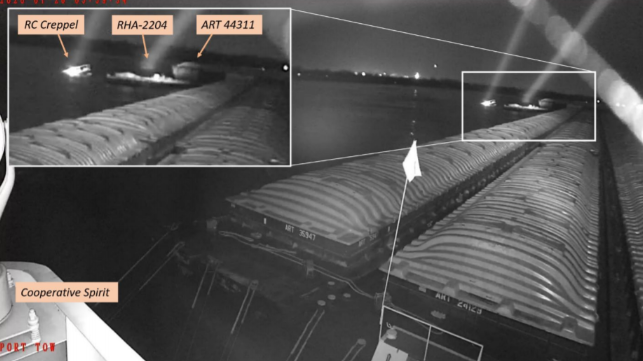NTSB: Wrong AIS Presets, Poor Comms Led to Deadly Barge Collision

The National Transportation Safety Board (NTSB) has issued its final report into the fatal collision between the towboats Cooperative Spirit and RC Creppel on the Mississippi River last year. The board concluded that inadquate passing arrangements and inaccurate AIS presets were the primary causes of the accident.
In the twilight morning hours of January 26, 2020, the Cooperative Spirit was towing 40 barges upriver and the RC Creppel was towing two barges downriver near Hahnville, just west of New Orleans. The water level was high, and the current was running at about 5.5 knots. The pilots of the two towboats made contact via VHF and reached agreement on a port-to-port meeting in the middle of a river bend. The RC Creppel's pilot informed the Cooperative Spirit of the size of his tow; the pilot aboard Cooperative Spirit pilot did not reciprocate.
As they approached, neither Cooperative Spirit nor RC Creppel were broadcasting accurate information about the dimensions of their vessels, NTSB reported. RC Creppel's AIS signal suggested that her length was 69 feet, but she was pushing a 450-foot-long tow. Cooperative Spirit's AIS presets were even further off: she broadcast her length as 200 feet, but her combined tow-plus-towboat length was over 1,600 feet. Neither had entered the beam of their vessel in the AIS presets.
At about 0533, the barges of the towing vessels collided near 26 Mile Point, and the RC Creppel rapidly capsized and sank. One of the Creppel's deckhands managed to abandon ship, and he grabbed a trailing wire from a nearby barge.
Several minutes later, as the situation was still unfolding, the upbound dry-bulk carrier Glory First collided with the starboard side of the Cooperative Spirit’s tow; the bulker's pilot had early warning of the obstruction and he successfully maneuvered to minimize damage.
Only the RC Creppel's deckhand was rescued, and the other three crewmembers were never found. The collision caused 42 barges to break loose from both tows, along with a spill of about 8,000 gallons of diesel and a release of sulfuric acid vapor from one barge. Altogether, the collision caused about $3 million in damage to three vessels and 11 barges.
In its report, the NTSB said a second radio exchange would have helped both towboat pilots identify each other’s expectations, but neither pilot made a call after the two vessels made passing arrangements. Since there was no call and no danger signal sounded, NTSB believes that neither vessel was aware of the risk of collision. Additionally, the inaccurate AIS presets for both vessels' dimensions left the two towboats without knowledge of each others' true size before they rounded the bend and came into sight.

that matters most
Get the latest maritime news delivered to your inbox daily.
"Since the Cooperative Spirit pilot did not inform the RC Creppel pilot of the size or length of his respective tow when they planned their meeting, nor did the RC Creppel pilot inquire as to its size, the RC Creppel pilot waslikely unaware of the length of the Cooperative Spirit tow, and the two pilots had arranged the meeting without a complete understanding of the developing situation. An improved picture of the vessels nearing each other would have occurred if either vessel’s AIS included the accurate size of the tows," NTSB concluded.
The NTSB has previously asked the U.S. Coast Guard and industry bodies to better regulate AIS broadcast settings for towboats, and it said that these recommendations have not yet been put into practice. "These safety recommendations need to be implemented to help save lives and prevent maritime tragedies," the agency advised.
